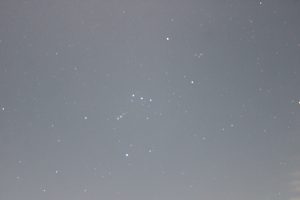Stargazing Spotlight: Exploring the Constellation Orion

Few constellations capture the imagination quite like Orion, the Hunter. Bright, bold, and filled with celestial wonders, it’s a favorite among amateur stargazers. In this post, we’ll explore how to find Orion, its notable features, and why it’s such a compelling target for anyone new to astronomy.
Finding Orion
Orion is most visible during the winter months in the Northern Hemisphere, from November through February. To spot it, look southward on a clear night. Orion’s most distinctive feature is its Belt—three bright stars arranged in a straight line, cutting through the center of the constellation. These stars are Alnitak, Alnilam, and Mintaka.
Once you’ve located the Belt, the rest of Orion’s shape unfolds around it. Betelgeuse, a reddish star, marks one shoulder, while the bright blue Rigel forms the opposite foot. Together, they create the outline of a hunter poised in the night sky.
Notable Features
Orion is packed with stunning celestial sights, making it an ideal target for beginners:
- Orion Nebula (M42): Just below Orion’s Belt lies his Sword, where you’ll find the Orion Nebula. This is a stellar nursery, a place where new stars are born. Under dark skies, it’s visible as a faint smudge to the naked eye. Through binoculars or a telescope, it comes alive with intricate clouds of gas and glowing light.
- Betelgeuse: This red supergiant is one of the largest stars visible to the naked eye. Its warm hue contrasts beautifully with Rigel’s icy blue light. Betelgeuse is also a variable star, meaning its brightness changes over time—adding a dynamic element to your observations.
- Orion’s Belt and Beyond: Follow the Belt’s line southeast to find Sirius, the brightest star in the sky, or northwest to reach Aldebaran in the constellation Taurus.
The Mythology of Orion
Orion’s story is steeped in mythology. In Greek lore, he was a mighty hunter, placed in the stars by Zeus. Different cultures have their own interpretations of Orion—for instance, ancient Egyptians associated the constellation with Osiris, the god of the afterlife. Learning these stories adds a layer of wonder to your stargazing sessions.
Observation Tips for Beginners
- Choose the Right Time and Place: Orion is best seen around 9:00 PM in January, high in the southern sky. For the best view, head to a location away from city lights.
- Use Basic Equipment: While Orion is easily visible with the naked eye, binoculars or a small telescope can enhance your experience, especially when exploring features like the Orion Nebula.
- Dress for the Weather: Winter nights can be chilly, so bundle up to stay comfortable during your stargazing session.
- Take Your Time: Let your eyes adjust to the dark, and take your time exploring the constellation’s many features.
Why Orion?
Orion’s brilliance and easy visibility make it an excellent starting point for amateur astronomers. It’s a gateway to understanding the night sky, offering a mix of stunning sights and rich stories that captivate both beginners and seasoned stargazers.
So grab your binoculars, find a clear night, and let Orion lead you on a journey through the stars. Happy stargazing!